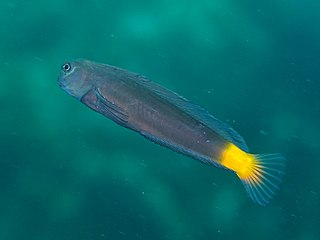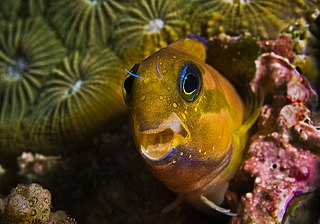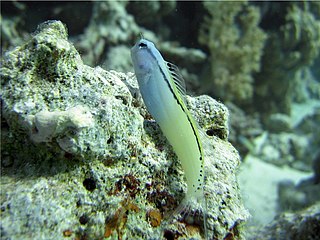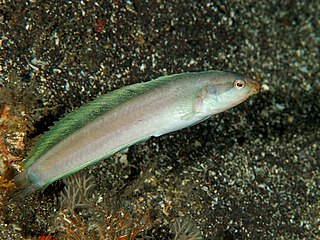
Ecsenius namiyei, commonly called black comb-tooth blenny or Namiye's coralblenny, is a species of marine fish in the family Blenniidae. The specific name honours the Japanese zoologist and museum curator Motoyoshi Namiye (1854-1915).

Ecsenius midas, known commonly as the Midas blenny, Persian blenny, lyretail blenny or golden blenny, is a species of marine fish in the family Blenniidae.

Ecsenius gravieri, the Red Sea mimic blenny, is a blenny from the Western Indian Ocean. It occasionally makes its way into the aquarium trade. It grows to a size of 8 cm in length. The specific name honours the French zoologist Charles Gravier (1865-1937), the collector of the type.

The Kirk's blenny is a species of combtooth blenny in the genus Alticus. It was described by A. Günther in 1964, originally as a member of the genus Salarias. It is a tropical blenny which is known from the Red Sea, Mozambique, Réunion, the Persian Gulf, and India, in the Indian ocean. Kirk's blennies inhabit waters near the shore, and often spend time out of the water. They are able to breathe air when on land. They are oviparous, and form distinct pairs when mating; they also guard their eggs. They can reach a maximum total length of 11 centimetres, and feed primarily off of benthic algae.
Cirripectes springeri, Springer's blenny or the spotted eyelash blenny, is a species of combtooth blenny found in coral reefs in the western Pacific ocean. This species reaches a length of 10 centimetres (3.9 in) TL.The specific name honours the American ichthyologist Victor G. Springer of the United States National Museum who has worked extensively on blennies.

Petroscirtes springeri is a species of combtooth blenny found in coral reefs in the northwest Pacific ocean. This species reaches a length of 7.7 centimetres (3.0 in) SL. The specific name honours the American ichthyologist Victor G. Springer of the United States National Museum, it was Springer who first introduced the author to the blenniids and who suggested the study in which Smith-Vaniz described this species.
Scartella springeri is a species of combtooth blenny found in the eastern Atlantic Ocean, around St. Helena. This species reaches a length of 8.2 centimetres (3.2 in) SL. The specific name honours the American ichthyologist Victor G. Springer of the U.S. National Museum.

Ecsenius aroni, known commonly as the Aron's blenny, is a species of combtooth blenny found in coral reefs in the western Indian ocean, from the Red Sea and the Gulf of Aqaba south to Djetta in Saudi Arabia and Towartit Reef near Port Sudan. The specific name honours the oceanographer William Aron of the Smithsonian Institution.

Ecsenius bathi, known commonly as the Bath's comb-tooth, is a species of combtooth blenny found in coral reefs in the western central Pacific ocean. The specific name honours the German ichthyologist Hans Bath (1924-2015) who was a notable worker on blennies and who brought this species to Springer's attention and allowed him to describe it.

Ecsenius alleni, known commonly as the Allen's blenny, is a species of combtooth blenny in the genus Ecsenius. It is found in coral reefs in the eastern Indian ocean, specifically in western Australia. It can reach a maximum length of 3.4 centimetres. The blennies feed primarily off of plants and algae. The specific name honours the ichthyologist Gerald R. Allen.
Ecsenius collettei, known commonly as the Collete's blenny in Papua New Guinea, is a species of combtooth blenny in the genus Ecsenius. It is found in coral reefs in the western central Pacific ocean, specifically in Papua New Guinea. It can reach a maximum length of 5 centimetres. The blennies feed primarily off of plants, and benthic algae and weeds. he specific name honours Bruce B. Collette the Director of the National Marine Fisheries Service Systematics Laboratory, whose collection of fish specimens from New Guinea contained a number important blenniid specimens, one of which was this species.
Ecsenius fourmanoiri, the blackstriped combtooth blenny, is a species of combtooth blenny in the genus Ecsenius. It is found in the western Pacific ocean. It can reach a maximum length of 4.9 centimetres. Blennies in this species feed primarily off of benthic algae and weeds. The specific name honours the French ichthyologist Pierre Fourmanoir (1924-2007), who collected the first specimens of this species and realised that it had not been described.

Ecsenius schroederi, known commonly as the Schroeder's combtooth-blenny in Indonesia, is a species of combtooth blenny in the genus Ecsenius. It is found in coral reefs in the western Pacific ocean, specifically in Indonesia. It can reach a maximum length of 7 centimetres. Blennies in this species feed primarily off of plants, including benthic algae and weeds, and are commercial aquarium fish. The species was named in honour of the wildlife artist and scientific illustrator Jack R. Schroeder (1954-2004).
Ecsenius lubbocki, known commonly as the Lubbock's combtooth-blenny in Indonesia, is a species of combtooth blenny in the genus Ecsenius. It is found in coral reefs in Phuket, Thailand, in the eastern Indian ocean. It can reach a maximum length of 4 centimetres. Blennies in this species feed primarily off of plants, including benthic algae and weeds. The specific name honours the English marine biologist Hugh Roger Lubbock (1951-1981), the collector of the type specimens, he recognised that they were a new species of Ecsenius.
Ecsenius portenoyi is a species of combtooth blenny in the genus Ecsenius. It is found in the western central Pacific ocean. It can reach a maximum length of 4.5 centimetres. Blennies in this species feed primarily off of plants, including benthic algae and weeds. Its specific name honours Norman S. Portenoy of Bethesda, Maryland for his support of the ichthyological expeditions of the National Museum of Natural History.
Ecsenius randalli is a species of combtooth blenny in the genus Ecsenius. It is found the western central Pacific ocean, around Indonesia. It can reach a maximum length of 2 centimetres. Blennies in this species feed primarily off of plants, including benthic algae and weeds. The specific name of this blenny honours the American ichthyologist John E. Randall of the Bishop Museum in Honolulu, who collected the type, photographed it and permitted Victor G. Springer to describe it.

Stanulus talboti, Talbot's blenny, is a species of combtooth blenny found in coral reefs in the western Pacific Ocean. This species feeds primarily on plants, including benthic algae and weeds. This species can reach 4.8 cm (1.9 in) in TL. This fish is also found in the aquarium trade.
The yellow-mouth pikeblenny is a species of chaenopsid blenny found in coral reefs in the eastern central Pacific ocean. It can reach a maximum length of 8 centimetres (3.1 in) TL. The specific name honours the carcinologist Waldo L. Schmitt (1887-1977) who was Curator of the Division of Marine Invertebrates in the US National Museum and who was responsible for the collection of the two types.
Stathmonotus hemphillii, the blackbelly blenny, is a species of chaenopsid blenny found in coral reefs in the western central Atlantic ocean. It can reach a maximum length of 5 centimetres (2.0 in) TL. This species can also be found in the aquarium trade. The specific name honours the malacologist Henry Hemphill (1830-1914) who collected the type.
Medusablennius is a monotypic genus of combtooth blenny, its only member being Medusablennius chani, which is known only from a single reef in the Tuamotu Archipelago. It was recorded from surge channels in tidal flats. This species is characterised by having numerous cirii on its head which is why Springer named the genus after the gorgon Medusa, while the specific name honours William L. Chan who noted that the type was likely to be a species new to science.










